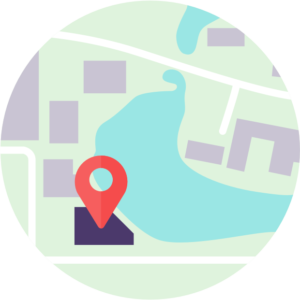We are committed to sharing unbiased reviews. Some of the links on our site are from our partners who compensate us. Read our editorial guidelines and advertising disclosure.
DSL vs. Cable vs. Fiber vs. Satellite Internet—Compare Internet Types
Data as of 10/20/22. Offers and availability may vary by location and are subject to change.
Do you have the right broadband internet connection for your business? And what does “broadband” mean anyway? If you’re like us, you’ve asked yourself these questions, maybe because you just started up or bought a new business or decided your office needed a change.
Broadband is an umbrella term that refers to just about any type of residential or business internet that is faster than dusty, old dial-up connections. Broadband connections are typically “wireline,” which means you get connected to your high-speed Internet Service Provider (ISP) through a complex chain of cables. But there’s also wireless broadband, most notably in the form of satellite internet that is broadcast from stations orbiting the planet.
But that doesn’t answer which internet service is best for your business. Unfortunately, the answer isn’t as simple as picking a winner—each type has its own benefits, flaws, and quirks.
On this page, we cover all the major types of internet connections and compare them in one-on-one matches so you can find the right connection to boost your business.

DSL vs. fiber vs. cable vs. satellite: A quick and dirty internet comparison
DSL: Low-tech but high-speed internet
Digital Subscriber Line (DSL) is a type of fixed wireline broadband internet that travels along existing copper telephone lines. In the late 1990s, DSL became one of the first widely available broadband connections after the dial-up access age.
Fast facts
- Download speeds from 1 to 500 Mbps
- Upload speeds from 384 Kbps to 8 Mbps
- Prices from $20 to $300 per month
Although DSL uses telephone lines like dial-up connections do, DSL’s “two-wire” technology allows you to get broadband internet without interfering with your phone services. Your business gets connected via a DSL modem that in turn connects to your devices using local or wireless internet connections.
One note about the term DSL: many current DSL Internet Service Providers have networks that use a combination of DSL, fiber-optic, or other connections. So the line that connects your office to the company’s port may be along copper wires, but the wider network in your neighborhood and city could be connected by fiber-optic cables that push connection speeds to much higher levels than traditional DSL. For the purposes of this page, we use DSL to refer to any of these networks.
AT&T offers fast broadband plans at affordable prices and provides businesses with top-notch customer service.
There are a couple different types of DSL internet, the main two being ADSL and SDSL. The A and S stand for “asymmetric” and “symmetric,” respectively. ADSL connections tend to have faster download speeds than upload speeds, which is fine for businesses that don’t do a ton of upload-heavy file sharing. SDSL typically has matching upload and download speeds, which is great for video conferencing, but it’s not as widely available as ADSL. Two other DSL types—VDSL (very high speed digital subscriber line) and HDSL (high-bit-rate digital subscriber line)—offer faster speeds than ADSL or SDSL.
DSL is more reliable than dial-up access. But according to the FCC, DSL speeds often don’t reach what ISPs advertise.2 The availability of DSL broadband is high thanks to the widespread installation of required lines. However, your ability to get DSL internet may depend on how close your office is to a phone line facility.
Is DSL right for my business?
Cable internet: Not just for TV
The same connections that have been enabling people to flip from ESPN to Food Network for years can provide broadband to your small business. Widely available cable broadband internet traditionally comes through coaxial cables.
Fast facts
- Download speeds from 20 to 1,000 Mbps
- Upload speeds from 7 to 50 Mbps
- Prices from $50 to $500 per month
Your cable ISP will equip your office with a cable modem that attaches to a wall outlet. The cable modem then connects to your computer and devices via ethernet cables or through a Wi-Fi router’s network. You can also set up a local area network (LAN) or wide-area network (WAN) to keep your devices connected and in sync.
A downside of cable internet is that the copper coaxial cables are susceptible to electrical surges or heat damage. The fastest and most reliable cable connections use HFC cables—which aren’t as prone to electrical surges—and DOCSIS 3.0 cable modem technology.
According to a 2016 FCC study, cable plans reached advertised speeds more reliably than DSL plans did.3 Yet a potential risk stems from traditional cable internet sharing connections with other subscribers in the area. That means that during peak times, you could experience lagging speeds as your neighbors drink from the same well of internet juice.
Some ISPs offer dedicated cable internet access to avoid this problem. A dedicated line is what it sounds like: a connection dedicated to only transmit from the ISP to your business. Dedicated lines provide much faster and more reliable internet for cable subscribers but cost a premium.
Is cable right for my business?
With download speeds reaching 400 Mbps and impressive TV packages, Spectrum is a solid choice for small businesses.
Runner-up: Optimum
Optimum’s business internet plans are similar to Spectrum’s in speed and pricing—in fact, they offer speeds up to 500 Mbps, just higher than Spectrum. Right now, we recommend Spectrum over Optimum as a cable provider because of availability. Optimum is only available in New York, New Jersey, and Connecticut, while Spectrum is available in 46 states.
However, Spectrum’s parent company, Charter, has been going through some legal troubles—particularly in New York. As of February 2019, the government still hasn’t determined whether it will require Charter Spectrum to remove service from the state.
We think the legal and customer service issues are troubling enough to include an alternate cable recommendation for businesses in the New York area. If you’re out of state, we still recommend Spectrum, but we’ll keep our eye on its customer service ratings and update our ranking accordingly.
Optimum’s affordable, contract-free plans and speeds up to 5,000 Mbps download/5,000 Mbps upload make it a great choice for Tri-State-area businesses on a budget.
Fiber internet: Freaking fast
Fiber-optic internet is the newest entrant in the broadband race. It’s a technology that can provide some seriously stunning speeds and solid reliability for small businesses.
Fast facts
- Download speeds from 25 Mbps to 1 Gbps
- Upload speeds from 5 to 880 Mbps
- Prices from $50 to $650 per month
Fiber internet connection gets its name from the glass or plastic fiber cables that substitute copper DSL or coaxial cables. Your fiber ISP will provide you with a modem or a gateway router to connect your office and devices.
Verizon's Fios fiber internet is fast, fast, fast with speeds up to 1 Gig for businesses that need a reliable, fast connection that does not quit no matter where they are in the country.
Tiny fibers the size of a width of hair transmit data with beams of light (that’s the “optic” part), which means the cables can carry higher bandwidth at higher speeds and with higher reliability than DSL or cable. And many fiber internet plans are “symmetrical,” which means your upload speeds match or nearly meet download speeds.
Fiber-optic internet isn’t as prone to problems from distance, frequency interference, and heat damage because glass and plastic don’t easily conduct electricity. But note that the actual speeds and reliability you get from your ISP can depend on things like the exact type of fiber network you’re connected to and the plan you purchase.
The biggest disadvantage of business fiber internet is that it’s only available in limited areas throughout the US. Because fiber is a new technology, ISPs are still working to build fiber-optic networks. As of 2015, only about one quarter of the US population had fiber broadband internet access.4
Is fiber right for my business?
Satellite internet: Beamed to your business
For businesses in rural or remote areas without access to landline internet like DSL, cable, or fiber, satellite technology is a lifesaver.
Fast facts
- Download speeds from 1 to 100 Mbps
- Upload speeds from 1 to 4 Mbps
- Prices from $50 to $500 per month
If you’re a satellite internet subscriber, your office will be equipped with a receiver dish pointed to the southern skies. You’ll get your data from earth-orbiting stations operated by ISPs. The satellites transmit data to the dish using radio frequencies that are converted into internet signals by a modem inside your office.
Current satellite internet technology can’t deliver connection speeds as fast as DSL or cable, and it’s nowhere near as fast as fiber. Why not? The stations orbit Earth at distances reaching 23,000 miles away—nearly 10 times the width of the continental United States. Data taking such a massive trip simply can’t travel fast enough.
These far-reaching distances also lead to reliability problems. Satellite internet suffers from high latency, resulting in delays between connection points. Plus, interference from clouds, bad weather, and even tall trees can slow your satellite connection or stall it altogether for a minute, an hour, or more—a major problem for businesses that need round-the-clock access. The cost for satellite internet is also much higher for the speeds delivered.
The fastest satellite speeds available make Viasat the best choice for rural offices that don’t have access to broadband wireline internet.
Plus, Viasat—one of just two satellite internet options across the country and by far the best provider—is working on bringing satellite up to speed. Viasat’s tech support is available 24/7, they’ve eliminated hard data caps (“soft” data caps can still slow your speeds, but you won’t lose internet access entirely), and speeds range from 35 Mbps (more than enough for two to three employees) to 100 Mbps in some areas.
Some Viasat internet plans start out at an incredibly reasonable $50 per month. Bear in mind, though, that the initial $50 cost likely jumps up in price after a few months; plan costs with Viasat can reach up to $500 per month.
Is satellite right for my business?
The fastest internet type: Fiber
In case it wasn’t crystal clear, fiber is fast. If you’re looking for a connection that can move at lightning speeds, fiber is your best option.
Although new technologies are pushing some DSL and cable speeds into the several-hundred-megabits-per-second range, nothing compares to the unadulterated pace of a pure-fiber connection.
With ISPs like Verizon and AT&T offering gigabit plans, you can connect your office to fiber for lightning-fast downloads and uploads. Internet speeds at this pace are great for complex cloud computing and near-seamless file sharing and backups—which can boost your small business into the future.
With fiber plans starting at $55 per month for 500 Mbps download/500 Mbps upload, Frontier offers a considerably affordable entry-level fiber connection.
The cheapest internet type: DSL or cable
Are you more of a budget-conscious business decision maker? Fortunately, both DSL and cable ISPs offer plans that give you decent internet speeds at sensible prices.
For higher-speed plans, we found cable ISPs to be more affordable than DSL. For example, Spectrum offers an $49 cable plan for 300 Mbps while Centurylink’s $85 plan gives you only 40 Mbps.
Fiber and satellite tend to be—for different reasons—more expensive than DSL or cable internet on average. In short, DSL is the cheapest internet type for lower-speed plans. Cable is the cheapest for higher speeds.
The most reliable internet type: Fiber
Fiber is fast, yes. But it’s also über-reliable. So if delay-free internet is critical to your business, fiber is the safest bet.
The tiny glass or plastic fibers used to deliver internet are less liable to heat and electricity damage and have a lowered risk of service outages from storms. The lightspeed connections also mean that data travels faster in shorter distances than any other connection type, reducing latency (delay) concerns.
The best internet access for rural offices: Satellite
Satellite internet is often the only option for businesses in sparsely populated areas, so if that’s you, then it’s the clear winner in a race of one.
Yet some offices may have access to only dial-up connections or low-speed, copper-wire DSL internet—in which case, satellite is the best option. With download speeds up to 100 Mbps in some areas and at least up to 35 Mbps in most others, plus close-to-perfect accessibility, satellite internet is your best bet if you can’t get DSL, cable, or fiber.
One caveat: fixed wireless internet is another option for some businesses. Fixed wireless providers use radio towers to transmit internet to a modem inside your office. This type of internet can be more reliable than satellite, but speeds tend to be lower, maxing out around 10 Mbps. Fixed wireless broadband is also much less available than satellite internet—another reason we can’t call it the winner.
By signing up I agree to the Terms of Use and Privacy Policy.
Head-to-head: Which connection is better?
It’s time for the main event—let’s pit internet types against each other in the ultimate internet showdown. From speed to reliability, which type will reign supreme?
DSL vs. fiber-optic internet
Round one: Speed
Traditional DSL internet is much slower than plans offered by fiber ISPs. And even newer technology like VDSL can’t match the mind-blowing speeds of fiber gigabit connections. Round one goes to Fiber.
Round two: Affordability
Although some fiber plans start around $20, their speeds aren’t worth the switch from DSL if it’s available. If you don’t need the super-fast speeds of fiber, DSL is the more affordable choice. Round two goes to DSL.
Round three: Reliability
DSL is a more reliable option than dial-up internet. But because DSL providers give you access through your business’s phone line, you could lose your connection if the phone lines are damaged or interrupted. Fiber-optic is much more reliable, in part because it’s a passive system that doesn’t need electricity to power the network. Round three goes to Fiber.
Round four: Access
DSL is widely available to businesses across the country. Fiber is only available to a fraction of customers—so far. But fiber internet access is growing. Round four goes to DSL.
And the winner is . . . It’s a tie!
Fiber vs. satellite internet
Round one: Speed
This one was easy. Fiber—the fastest option—totally wastes satellite—the slowest option—in the speed race. No contest. Round one goes to fiber.
Round two: Affordability
Another easy win for fiber, which is more expensive than DSL or cable on average but still cheaper than satellite when matching speed for speed. Round two goes to fiber.
Round three: Reliability
Satellite internet is no match for the supremely reliable technology in fiber-optic connections. Round three goes to fiber.
Round four: Access
It’s not a total KO for satellite. Only some businesses can access fiber internet, while nearly any office can connect to a satellite ISP. Round four goes to satellite.
And the winner is . . . fiber!
Cable vs. fiber internet
Round one: Speed
Over the last few years, cable has caught up to fiber in terms of speed: some cable providers offer speeds up to 1,000 Mbps, or 1 Gig, which is often the highest speed you can get with fiber, too. However, cable can’t offer symmetrical upload and download speeds, and fiber in some areas can surpass a full gig. Round one goes to fiber.
Round two: Affordability
Although fiber plans are often a better value for their speed than cable, if you’re looking for cheaper internet plans to run your business, cable prices usually start lower. Round two goes to cable.
Round three: Reliability
Cable and fiber are generally reliable internet types. But fiber wins this round because the fiber-optic cables are safer from damage and outages than traditional coaxial cable internet. Round three goes to fiber.
Round four: Access
Cable is widely available thanks to Americans’ love for cable TV. If your business can receive cable television, it can most likely access cable internet. And although cable isn’t available in some rural locations, fiber connections are even less so. Round four goes to cable.
And the winner is . . . It’s a tie!
DSL vs. satellite internet
Round one: Speed
Satellite can’t beat DSL in download or upload speeds. The fastest satellite internet you can get maxes out at 100 Mbps, while DSL can get you into the hundreds of megabits per second. Round one goes to DSL.
Round two: Affordability
Another loss for satellite. Satellite internet is almost always more expensive than DSL, with plans that range from about $50 to $200 per month—plus the costs of buying or leasing a satellite dish. DSL plans can run as cheap as $20 per month for low speeds, and even $50 for moderate speeds. Round two goes to DSL.
Round three: Reliability
Satellite loses the reliability round too because its signal can be blocked or interrupted by trees, mountains, structures, bad weather, and even sunspots. Round three goes to DSL.
Round four: Access
DSL may be available to the majority of businesses, but satellite ISPs can provide access to almost any office in the world with a clear view of the sky. Round four goes to satellite.
And the winner is . . . DSL!
DSL vs. cable internet
Round one: Speed
Cable wins the speed round. Newer VDSL and HDSL technology can deliver speeds close to 100 Mbps, but many commercially available cable plans exceed 200 Mbps—some up to 500 or even 1,000 Mbps. Round one goes to cable
Round two: Affordability
DSL plans tend to be cheaper than cable plans at lower speeds. Cable internet often costs more, but you do get the option of faster plans with cable. Round two goes to DSL.
Round three: Reliability
Cable and DSL both provide an “always-on” connection, which means that as long as your computer is on, it’s connected to the internet. You may lose your connection from damaged cable or telephone lines, but both internet types provide about the same reliability. Round three is a tie.
Round four: Access
As long as your business can receive television cable service, you can likely get cable internet. A similar truth holds for DSL: most offices connected to telephone lines can access DSL internet services. Round four is a tie.
And the winner is . . . It’s another tie!
Cable vs. satellite internet
Round one: Speed
This round is pretty simple. Satellites can’t beam internet to your business nearly as fast as cable ISPs can. Round one goes to cable.
Round two: Affordability
Comparing Mbps to Mbps, cable is the clear winner for price. Satellite is much more expensive, and most subscribers choose it because it’s the only option for them. Round two goes to cable.
Round three: Reliability
Satellite loses the reliability race thanks to it having to travel much farther into space to reach you. Round three goes to cable.
Round four: Access
Win one for satellite—it’s available almost everywhere. Although most US companies can access cable internet, satellite is still more widely available. Round four goes to satellite.
And the winner is . . . cable!
The takeaway
There’s no single winner in our types of internet connections melee—the best type is the one that meets your business needs. If you need the fastest speeds, consider fiber. If your budget is tight, try a low-cost DSL plan. Or if your office is remotely located, satellite’s probably your best option. In the end, the connection that balances your cost, speed, and service requirements will be your champion.
Disclaimer
At Business.org, our research is meant to offer general product and service recommendations. We don't guarantee that our suggestions will work best for each individual or business, so consider your unique needs when choosing products and services.
Sources
1. Wired Score, “Commercial Tenants Will Pay More for an Office with Superior Connectivity”
2. FCC, “Measuring Fixed Broadband Report—2016”
3. FCC, “Measuring Fixed Broadband Report—2016”
4. National Broadband Map, “Broadband Statistics Report”
Internet FAQs
If you read each of the internet showdowns above, you should have an understanding of how each type compares to the other. But choosing the right connection for your business depends on several factors.
Here are five questions you should ask yourself when deciding the best connection for your office:
- What’s available? Internet access for many businesses is limited to only one or two kinds of internet—which is unfortunate but makes the decision easier. Find out which internet plans are available in your area to begin your search.
- What’s my budget? Don’t blow out your bottom line just to get the fastest speeds available. Determine what your business can afford per month, and then look for plans that meet your criteria. You can always switch later.
- How much speed do I need? If your business relies on constant, complex online computing, you’re going to need seriously fast speeds. But if you just need to do some day-to-day browsing and downloading, you can probably get away with lower speeds.
- How important is reliability, customer service, security, and technology? Speed and price aren’t the only factors to consider. Ask if your potential ISP has reliability or technical support guarantees. Look around for customer service ratings (although be warned: most ISPs don’t have the best reputations). And see if you can get free or discounted technology upgrades like cloud storage, VoIP services, and security software.
- Can I save by bundling internet with phone or TV? Finally, business ISPs love to bundle. Although you may not need sophisticated TV or phone services, you may be able to save on the full package by combining offers.
For even more details, read how to choose an internet service provider for your business.
It’s a good idea to take a new look at your business internet options any time your business expands, your budget changes, or you’re nearing the end of a contract with a current ISP. You could benefit from changing to a new plan, but be careful—there are some potential downsides of switching providers.
- The benefits of switching ISPs: You could potentially lower your costs, raise your speeds, access more functionality, and get better customer service and technical support.
- The disadvantages: You may have to pay early termination fees and new equipment or installation costs, and you could lose email or service accounts (security suites, cloud backups, etc.).
We covered the major contenders in the internet wars, but there are a few others worth mentioning.
- Cellular: You can do business using your cellular provider’s data plan. Many smartphones let you set up “hotspots” to connect a computer to a wireless network. This is a good option for on-the-go business, but it’s too slow and expensive for long-term, data-heavy usage.
- Dial up: Many residents are still popping AOL discs into their computers and dialing into their telephone carriers to access the internet—and some businesses too! It’s notoriously slow, but dial-up internet hasn’t yet disappeared entirely.
- Ethernet: This is not a primary internet connection. Rather, Ethernet is a way to connect devices to each other in a local area network (LAN) or to your primary ISP router or modem.
- Fixed wireless: As an alternative to satellite internet for some rural offices, you may be able to get a fixed wireless broadband connection that uses radio frequencies sent from nearby towers. It’s more reliable—but not usually faster—than satellite internet.
- T1: T1 lines offer a dedicated and reliable way for businesses to get internet. The advantage of a T1 line is that the ISP usually guarantees your connection to be online at a certain percentage. You also don’t share your T1 connection with any other subscribers, unlike most cable connections. On the other hand, the high cost for T1 lines tends to make it unattractive to small businesses.




